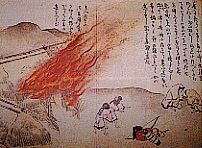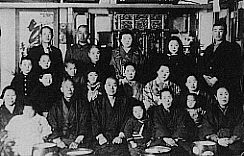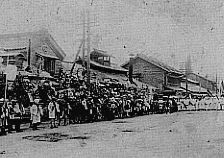北の生活文化(Family structure of the Ainu )
| Individuals were the basic units in the Ainu's egalitarian society in which the work was shared in accordance with differences in gender and the culture related to the paternal or maternal lineages was transmitted by the male or female members of the family respectively. The kinship system existing in Japanese society in Hokkaido was organized based on the individual family owing to the fact that settlers could become self-sustained, independent farmers. The type of kinship structure seen in traditional Japanese society therefore was not formed in Hokkaido. |
| Family structure of the Ainu |
 |
 |
| 42. Men offering a prayer at the altar |
43. Burning down the house |
The families of Ainu people consisted of a couple and their children with children moving to new houses of their own when they grew up. When a daughter reached a marriageable age in past times her parents used to build a small house within the close vicinity of the parents' home so that the daughter could live alone. This arrangement was made in order that she would be able to invite prospective male courters to visit and to choose the one with whom she could best get along for marriage. Some young men remained in the brides' houses after marriage while others took the women to their own houses. The eldest son built his house close to his parents to take care of them and to inherit the assets of his father's family. When his wife passed away the husband had his house burned down and moved to his relatives' house and did not own a house until he was remarried. A husband who had lost his wife was referred to as a "man without a house."
The basic unit forming the Ainu people's society was that of the individual. Marital relationships would be extinguished by the death of one party or by divorce. The relationships between fathers and sons and between mothers and daughters were emphasized in the relationships between parents and children. Even relationships between children born of the same parents were gender oriented as seen in the exclusive relationships existing among children of the same sex. Relationships of this sort were extended further to following generations of children and grandchildren on which cohesion among all the relatives was based. There are no expressions in the Ainu language found to exactly describe a social unit that is composed of families and their kinship families which encompass and include both sexes. |
| Rites and ceremonies in the life of the Ainu |
 |
 |
| 44. Girls learning patterns of clothing by drawing them on the sand |
45. Tattooed woman with ears rings, the
end of the 19th century or early Meiji |
According to the belief of Ainu people, birth signifies the beginning of a soul dwelling in a body. The soul immediately after birth is vulnerable and could easily leave the body and therefore special attention and care are required. When the soul enters into a body a guardian deity for the baby is born as well and that deity will live with the child as long as the child lives. The deeds of guardian gods vary according to individuals, yet they commonly have the ability to predict the occurrence of both good and bad events. When people experienced a flutter of the heart they thought a guardian deity was trying to indicate that something was about to happen and prayed seeking advice from the god.
When a man had come of age, he was taught by his father or grandfather how to engrave and take care of the family emblem representing his father's bloodline. At this time the origin of his father's kinship family was revealed to him for the first time.
Women possessed small strings which were worn on their chests and which carried a special meaning for them. Their husbands alone were allowed to touch the strings and as girls were growing to become women they often half-consciously reached for these strings, displaying their awareness that their breasts were developing and that their bodily contours were changing. Some women put a needle of much value to them inside the string and then covered it with a wooden case. A needle was considered a precious item for women as indicated in the story in which the goddess of fire looked through the hole in a needle to find her husband's whereabouts. She found him visiting the goddess of water and retrieved her husband by divine power through the use of a needle. |
| Japanese kinship structure in Hokkaido |
 |
 |
| 46. Soldier Farmer Family in Kamiyubetsu, 1942 |
47. Funeral in Kikusui, Sapporo, 1923 |
Family and kinship structures seen in Hokkaido have their basis in the Tohoku and Hokuriku regions from where two thirds of immigrants came. The relationship between the head family and the collateral families is defined within a large kinship structure while creating the relationship between a landowner and his tenant farmers. The dual relationship long existing between the two parties through generations was not formed in Hokkaido.
The immigrants had to move from one place to another in pursuit of land with more desirable conditions for a family to lead a stable life. Marriages were formed between parties having the same origins or between cousins during the initial period of development. Members of farming families could easily become self-sustaining, independent farmers since a vast amount of undeveloped land was available in Hokkaido and the kinship structure of the head family and collateral families was limited to two or three generations. The rigidly defined kinship structure seen in Honshu was not transmitted to Hokkaido because of the social changes occurring during post-war agricultural land reform and industrialization and the consequent increase in the population in-flow. However some customs existing in more traditional societies are also found in Hokkaido such as the priority given to the husband which is applied when deciding the seating order at a wedding reception and the order of offering incense at a funeral service no matter if men belong to the husband's family or not. Notably the family and kinship structures in Hokkaido are based on individual families with slightly more emphasis given to the father's family. However, these structures are characterized basically by the equal functions played by the families of the father and the mother. |

